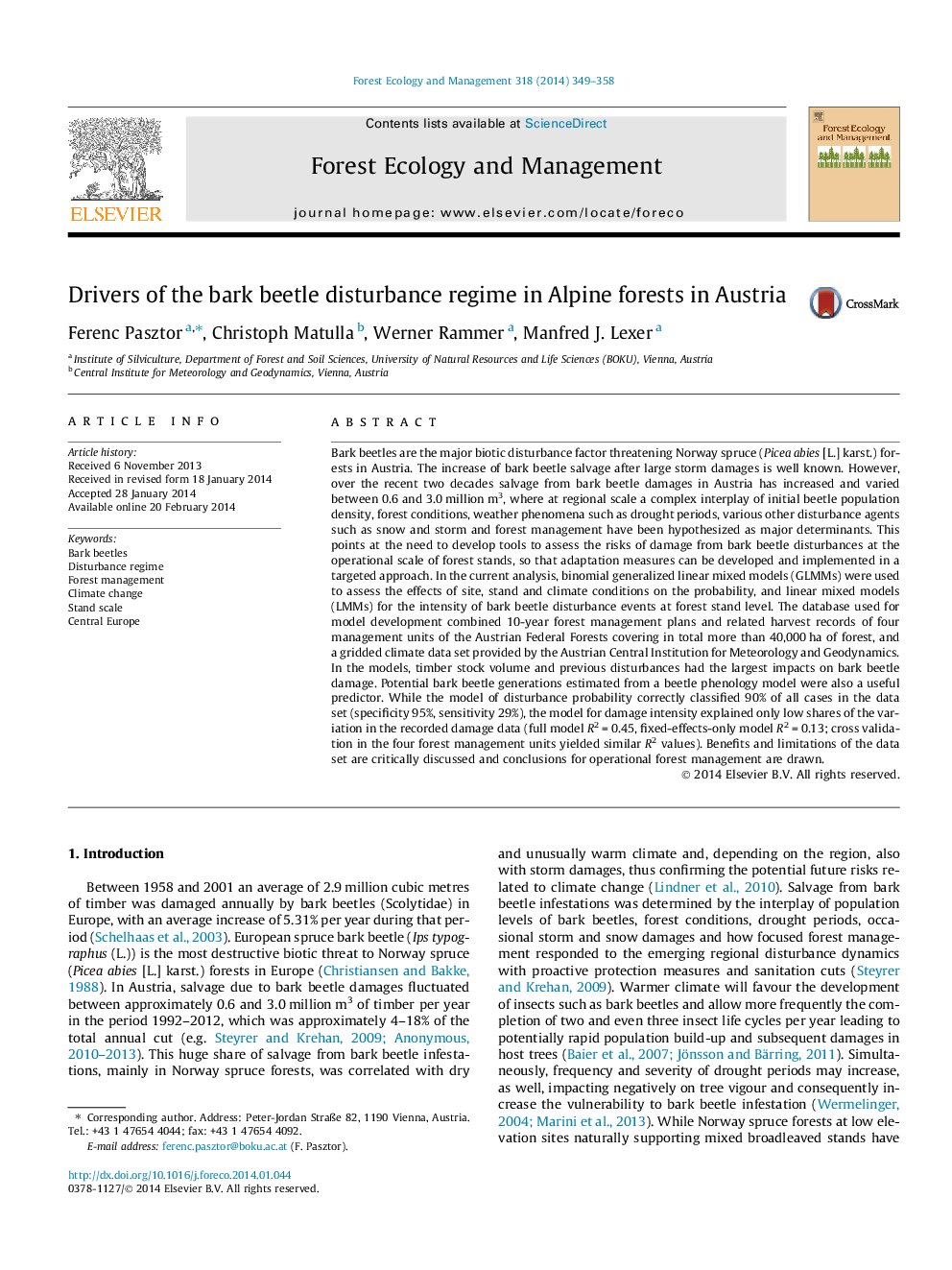| کد مقاله | کد نشریه | سال انتشار | مقاله انگلیسی | نسخه تمام متن |
|---|---|---|---|---|
| 6543633 | 159214 | 2014 | 10 صفحه PDF | دانلود رایگان |
عنوان انگلیسی مقاله ISI
Drivers of the bark beetle disturbance regime in Alpine forests in Austria
ترجمه فارسی عنوان
رانندگان اختلال سوسک کوسه در جنگل های آلپ در اتریش
دانلود مقاله + سفارش ترجمه
دانلود مقاله ISI انگلیسی
رایگان برای ایرانیان
کلمات کلیدی
سوسک خرچنگ، رژیم اختلال، مدیریت جنگل، تغییر آب و هوا، مقیاس پایه، اروپای مرکزی،
موضوعات مرتبط
علوم زیستی و بیوفناوری
علوم کشاورزی و بیولوژیک
بوم شناسی، تکامل، رفتار و سامانه شناسی
چکیده انگلیسی
Bark beetles are the major biotic disturbance factor threatening Norway spruce (Picea abies [L.] karst.) forests in Austria. The increase of bark beetle salvage after large storm damages is well known. However, over the recent two decades salvage from bark beetle damages in Austria has increased and varied between 0.6 and 3.0 million m3, where at regional scale a complex interplay of initial beetle population density, forest conditions, weather phenomena such as drought periods, various other disturbance agents such as snow and storm and forest management have been hypothesized as major determinants. This points at the need to develop tools to assess the risks of damage from bark beetle disturbances at the operational scale of forest stands, so that adaptation measures can be developed and implemented in a targeted approach. In the current analysis, binomial generalized linear mixed models (GLMMs) were used to assess the effects of site, stand and climate conditions on the probability, and linear mixed models (LMMs) for the intensity of bark beetle disturbance events at forest stand level. The database used for model development combined 10-year forest management plans and related harvest records of four management units of the Austrian Federal Forests covering in total more than 40,000 ha of forest, and a gridded climate data set provided by the Austrian Central Institution for Meteorology and Geodynamics. In the models, timber stock volume and previous disturbances had the largest impacts on bark beetle damage. Potential bark beetle generations estimated from a beetle phenology model were also a useful predictor. While the model of disturbance probability correctly classified 90% of all cases in the data set (specificity 95%, sensitivity 29%), the model for damage intensity explained only low shares of the variation in the recorded damage data (full model R2 = 0.45, fixed-effects-only model R2 = 0.13; cross validation in the four forest management units yielded similar R2 values). Benefits and limitations of the data set are critically discussed and conclusions for operational forest management are drawn.
ناشر
Database: Elsevier - ScienceDirect (ساینس دایرکت)
Journal: Forest Ecology and Management - Volume 318, 15 April 2014, Pages 349-358
Journal: Forest Ecology and Management - Volume 318, 15 April 2014, Pages 349-358
نویسندگان
Ferenc Pasztor, Christoph Matulla, Werner Rammer, Manfred J. Lexer,
